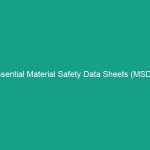Good morning team!
Today, we’re diving into an important topic: Essential Manual Handling Injury Prevention Guidelines You Must Know. Understanding these guidelines is not just about compliance; it’s about ensuring your Safety and well-being every day at work. Manual Handling incidents can lead to severe injuries, affecting not only your health but also your ability to perform your job efficiently. Let’s ensure we are all equipped with the knowledge to avoid these risks!
Understanding Essential Manual Handling Injury Prevention Guidelines
Manual handling involves lifting, carrying, pushing, or pulling items. It is a fundamental part of many jobs, but it also poses significant risks. According to Safety statistics, manual handling injuries account for a large percentage of workplace injuries, including back pain and musculoskeletal disorders.
It’s essential to recognize that these injuries can occur from improper lifting techniques or overexertion. A common misconception is that only heavy items pose a risk; in reality, even lighter objects can cause injury if handled incorrectly.
Key Hazards, Risks, and Safety Considerations
Understanding the Hazards associated with manual handling is crucial for injury Prevention. Here are some specific risks:
- Improper Lifting Techniques: Using your back instead of your legs can lead to serious back injuries.
- Overexertion: Lifting items that are too heavy or awkward can lead to sprains and strains.
- Environmental Factors: Slips, trips, and falls can occur if the workspace is cluttered or poorly organized.
- Fatigue: Continuous manual handling without breaks can increase the risk of injury.
The consequences of ignoring these hazards are severe. They can lead to chronic pain, long recovery times, and even disability in extreme cases. It’s vital to take these risks seriously to ensure a safe working Environment for everyone.
Best Practices, Procedures, & Actionable Advice
Now that we understand the risks, let’s discuss how to mitigate these hazards with practical steps:
1. Assess the Load
Before lifting, assess the load’s weight and size. If it appears too heavy or awkward, seek help or use mechanical aids, such as trolleys or hoists.
2. Use Correct Lifting Techniques
Follow these steps for safe lifting:
- Stand close to the load with your feet shoulder-width apart.
- Bend your knees, not your back.
- Keep your back straight and look forward.
- Grip the load securely with both hands.
- Lift with your legs, not your back, keeping the load close to your body.
- Use a smooth, controlled motion.
- Set the load down carefully, bending your knees again.
3. Maintain Good Posture
When lifting or carrying, maintain a neutral spine and avoid twisting your body. If you need to turn, move your feet instead of twisting at your waist.
4. Take Breaks
Regular breaks are essential to prevent fatigue. Alternate between different tasks to give your muscles a chance to recover.
5. Utilize Equipment
Whenever possible, utilize equipment designed to assist with lifting and moving heavy objects, such as forklifts or dollies.
Case Study Example
Consider the case of John, who worked in a warehouse and suffered a severe back injury due to improper lifting. He ignored the warning signs and continued lifting heavy boxes without assistance, resulting in a long-term injury that impacted his work and personal life. This example highlights the importance of following safe manual handling practices.
Regulations, Standards, and Compliance
Compliance with safety Regulations is critical for protecting employees. In the United States, the Occupational Safety and Health Administration (OSHA) provides guidelines for manual handling. Organizations must adhere to these regulations to ensure Workplace Safety.
By following these guidelines, not only do we comply with legal requirements, but we also foster a culture of safety that Benefits everyone. Remember, safety is everyone’s responsibility!
Employee Engagement & Discussion
Let’s open the floor for discussion. Here are some questions to consider:
- What safety challenges have you encountered related to manual handling?
- Have you ever experienced an injury while lifting? What could have been done differently?
- What equipment do you believe is most useful for manual handling tasks?
Your insights are valuable, and sharing experiences can help us all improve our safety practices.
Conclusion & Key Takeaways
In conclusion, understanding and implementing Essential Manual Handling Injury Prevention Guidelines is crucial for maintaining a safe work environment. Remember to assess loads, use correct lifting techniques, maintain good posture, take regular breaks, and utilize appropriate equipment.
Let’s commit to prioritizing safety in our manual handling practices. Each one of you plays a vital role in creating a safer workplace. Thank you for your attention and for your continued commitment to safety!

